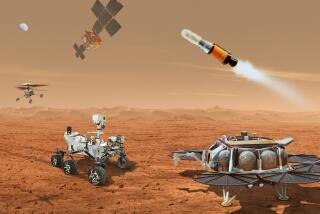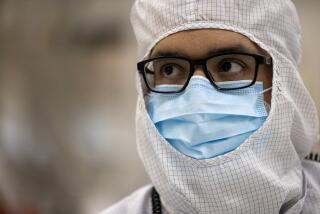Hubble’s last fix-it mission is riskiest
- Share via
After 19 years of service, during which time it has provided the most eye-popping images ever of galaxies, nebulae and, most recently, of a planet orbiting an alien star, the Hubble Space Telescope is suffering the pains of old age. It’s unsteady, with only half its gyroscopes working, and several of its key science instruments are broken.
To restore the ailing telescope to its former glory, NASA on Monday is set to launch the fifth and final repair mission to the orbiting telescope.
The Hubble mission is unusually risky, even by space travel standards, involving five spacewalks and extended time in the debris-riddled layer above Earth, where even a small collision with space junk could render the shuttle useless. The vulnerability of the shuttle fleet to small bits of flotsam was tragically demonstrated by the destruction of the shuttle Columbia in 2003, which was hit during liftoff by a piece of foam insulation from the external fuel tank. The searing heat of reentry widened the hole on the left wing and destroyed the orbiter as it attempted to land in Florida.
Top NASA officials say they will do everything they can to ensure the safety of the crew of the shuttle Atlantis, including flying the orbiter upside down and backward to minimize the danger of being struck by space debris and having a second shuttle on the launchpad in case a rescue mission must be mounted.
“This is going to be an extremely challenging mission,” said shuttle pilot Greg Johnson.
Big Bang quest
If successful, the mission will leave the telescope with six new gyroscopes, six fully charged batteries, and four repaired or replaced cameras and spectrographs, including the workhorse wide-field camera No. 2 that was responsible for some of Hubble’s most dramatic images. The repairs will keep Hubble functioning at peak efficiency at least through 2014, by which time the next-generation James Webb telescope is scheduled to take its place.
This suite of upgraded instruments will enable the refurbished telescope to look back in time to the very beginnings of the universe.
“This will be our first realistic chance of detecting the first stars and galaxies that formed” right after the Big Bang, almost 14 billion years ago, said UCLA astronomer Matthew Malkan, whose team will be among the first users of the refurbished instrument.
Malkan estimates that the reborn Hubble will be 100 times as powerful as it was when it was carried to orbit in April 1990.
It might even be powerful enough to find the current Holy Grail of cosmology -- the source of the dark matter and dark energy that is thought to make up as much as 96% of the universe. Although neither has been detected directly, scientists believe they must exist to explain the behavior of galaxy clusters and the fact that the expansion of the universe is speeding up.
“I truly believe that 100 years from now people will still remember Hubble and what it did,” said David Leckrone, a senior scientist with the Hubble team.
The mission is not without controversy. In fact, it was canceled after the Columbia disaster, out of concern that a problem with Atlantis could leave the crew stranded in space. Then-NASA Administrator Sean O’Keefe declared at the time that the only safe destination for the shuttle fleet was the International Space Station, which could offer a haven to the crew of a damaged shuttle.
It took the intervention of Congress, which earmarked money to NASA with the restriction that it could be used only on a Hubble repair mission, and the appointment of a new administrator, Michael Griffin, to get the mission back on the manifest.
“I thought this was a mission we ought to be doing,” said Griffin, who recently left the agency for a teaching position at the University of Alabama in Huntsville. “For the cost of one shuttle mission, we get a chance to have a brand new telescope in Earth orbit.”
With most of its instruments hobbled or out of service, Hubble today “is like a champion athlete playing hurt,” Leckrone said.
On the to-do list
NASA’s schedule calls for Atlantis to rendezvous with Hubble on the third day of the 12-day mission. Mike Massimino is one of several crew members who has visited Hubble before. As a member of the 2002 mission, he recalls the thrill of catching a glimpse of the big telescope floating languidly in space.
“As you come up, it looks like a star on the horizon,” Massimino said.
After pulling alongside Hubble, crew member Megan McArthur will operate Atlantis’ onboard grappling arm to haul the school-bus-sized, 44-foot-long, 12-ton telescope into the shuttle’s payload bay, where it will be attached to a special berthing mount that will allow easy access to all its instruments.
Day 4 is when the real work begins, with the first of the five spacewalks, each lasting more than six hours.
The repair team will have at its disposal a kit of 180 tools, 116 developed just for this mission. And 316 bolts will be loosened and refastened as the spacewalkers wrestle the new instruments into position.
The weightlessness of space will be an ally as the spacewalkers struggle with massive instruments, such as a 900-pound wide-field planetary camera.
Even so, NASA says the sheer volume of work to be done over a relatively short period of time will make this the toughest, most tightly scheduled repair mission to date.
The spacewalkers will cut the telescope loose on the ninth day of their mission. Atlantis will then quickly descend to a lower altitude to reduce the risk of being hit by such orbital debris as old rocket parts, lost screwdrivers and castoff nuts and bolts. The region where the telescope orbits is much more congested with debris than the lower altitude, where the International Space Station orbits.
The danger is that even a small piece of debris traveling at 17,000 miles an hour could puncture the skin of the shuttle, rendering it unusable for the return trip to Earth.
NASA engineers have calculated that there is a 1-in-221 chance of a catastrophic accident caused by orbital debris that would destroy the shuttle and kill the seven-member crew. Some assessments have put the risk of danger even higher, at 1 in 167. That would violate NASA’s margin of safety, which states that a risk higher than 1 in 200 is unacceptable.
“We’ve paid close attention to this risk,” deputy shuttle program manager LeRoy Cain said in a recent briefing with reporters. “We feel it’s acceptable to go fly.”
Flying upside down and backward while the crew works on Hubble is one way of curbing risk. That configuration protects the shuttle’s nose cone and its vulnerable wing edges.
Rescue plan
If all NASA’s efforts to protect Atlantis fail and the orbiter is damaged, either during launch or by orbital debris, the crew will have to be rescued by a second shuttle. That shuttle, Endeavour, will be standing by on a nearby launchpad when Atlantis lifts off. Endeavour could blast off on a rescue mission within a matter of days, officials said.
Atlantis will carry 25 days’ worth of provisions, enough to tide the crew over should it need to wait for Endeavour. In a rescue, the Atlantis crew would be transferred one by one to the rescue orbiter. Then, Atlantis would be destroyed.
Massimino said he wasn’t worried about his safety. NASA has learned a lot since the Columbia accident, he said.
“If we do have damage, there is a pretty good chance we can go and fix it,” he said.
After Columbia was destroyed, NASA engineers developed repair techniques to plug holes, though none has been tried in a real emergency.
“If I was too concerned” about the risk, Massimino said in a phone interview from Johnson Space Center in Houston, “I wouldn’t be doing it.”
Critics said the willingness of the astronauts to put themselves in harm’s way should not be a consideration when deciding whether to permit a mission in space.
“Just because the astronauts are prepared to have a fancy funeral if something goes wrong, that doesn’t mean the taxpayers should have to pay for their blaze of glory,” said John Pike, a space policy analyst for GlobalSecurity.org.
The mission is just as risky now as it was when O’Keefe canceled it, Pike said, adding that the only thing that has changed is the politics.
Pike’s opinion is a minority one. Other observers said they thought NASA had worked hard to minimize risk.
They also say that changes to the shuttle fleet, such as redesigning the external fuel tank to minimize the amount of insulating foam that falls off during a launch, have made the shuttles safer than they were when Columbia was fatally damaged.
“Yes, it’s risky to fly in space, period. Yes, it’s risky to fly in a place with more orbital debris. But I believe these guys have calculated the danger pretty well,” said Roger Launius, a space expert and historian at the Smithsonian Institution in Washington.
“These are not teenagers with a souped-up engine running down the road at 130 miles an hour. The risk is certainly worth it in the context of keeping a world-class scientific instrument operating.”
--
More to Read
Sign up for Essential California
The most important California stories and recommendations in your inbox every morning.
You may occasionally receive promotional content from the Los Angeles Times.










